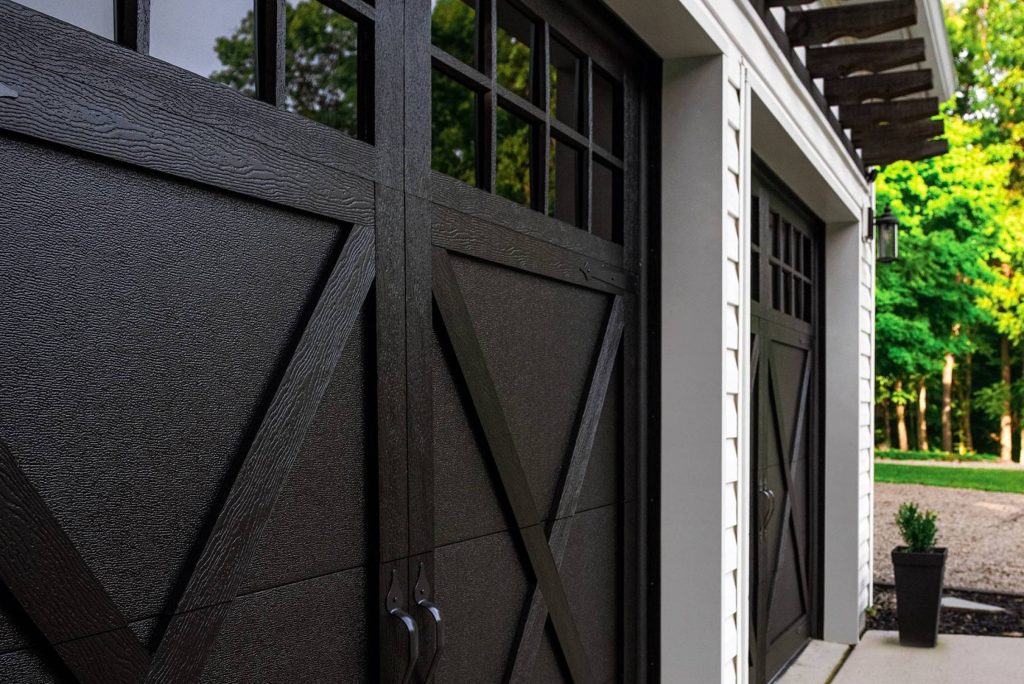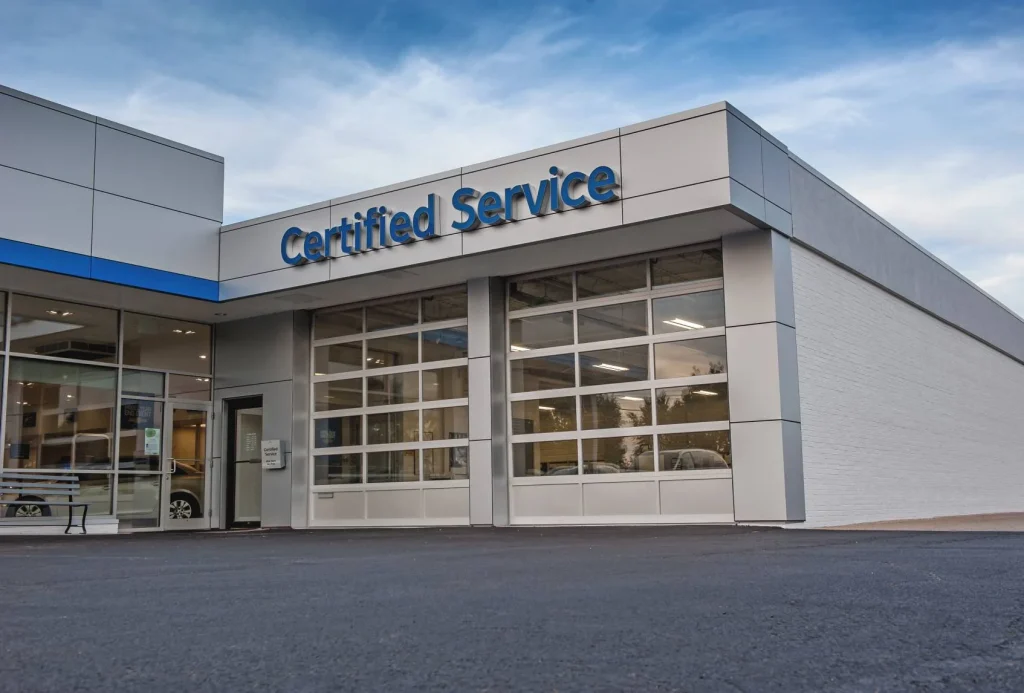Garage Door Service in Hazel Park, MI
Comprehensive Maintenance for Long-Lasting Performance
Locally Based, Regionally Trusted
Since 2017
Schedule A Service Request
We Serve Businesses In And Around The Following Cities:
About Garage Door Service
Comprehensive Guide to Garage Door Service for Commercial Properties in Hazel Park
The Critical Role of Garage Door Service in Commercial Properties
In the bustling industrial hub of Hazel Park, the importance of effective garage door service cannot be understated. For commercial enterprises, maintaining smooth and secure operations often hinges on the reliability of these essential structural elements. Whether it's ensuring the safe daily passage of goods and personnel or safeguarding the premises from unauthorized entry, garage doors serve as a critical component in many businesses' infrastructural armor. Their upkeep, therefore, becomes a paramount concern for property managers and business owners alike.
Understanding the intricacies of garage door service is vital for those operating in commercial properties. It's not simply about repairs when something goes wrong but about preventative measures, regular maintenance, and strategic upgrades to enhance the efficiency and security of business operations. Effective garage door service goes beyond the basics, addressing the unique demands and configurations specific to commercial settings.
Process and Techniques Involved in Garage Door Service
The process of servicing commercial garage doors in Hazel Park encompasses a variety of techniques and approaches tailored to meet the operational demands and safety regulations pertinent to businesses in the area. The service process typically begins with a comprehensive inspection, which provides a clear snapshot of the door's current state. This inspection focuses on identifying potential issues like misalignments, wear and tear, and structural weaknesses.
Technicians trained in garage door service near me will meticulously check every component, from springs and rollers to openers and panels. Regular servicing doesn't merely address visible problems; it involves scrutinizing parts that are often not visible to the untrained eye. The integration of lubrications, tightening of loose screws, and alignment corrections are standard during this phase. Also, given the intense usage typical in commercial properties, ensuring the operational capacity of mechanisms like the torsion springs is crucial, as their failure could lead to substantial operational delays.
The subsequent phase in garage door servicing involves actual repairs and replacements when necessary. Whether it's fixing malfunctioning sensors or replacing worn-out cables, thoroughification ensures the longevity and functionality of the system. Post-repair testing is essential, verifying that all components work together seamlessly to provide optimum performance.
Benefits of Regular Garage Door Servicing for Businesses
The advantages of regular garage door services and repair for commercial properties are manifold. Primarily, a well-maintained garage door enhances security, deterring unauthorized access and safeguarding valuable commercial assets. Regular maintenance checks reduce the risk of unexpected door malfunctions, which can lead to business downtimes and potentially substantial financial losses.
Furthermore, consistent garage door svc ensures compliance with safety standards, thereby mitigating legal liabilities associated with accidents or injuries resulting from faulty doors. Businesses in Hazel Park often operate in environments that require adherence to strict safety codes, and regular servicing ensures these standards are met unwaveringly.
Additionally, routine servicing proves cost-effective in the long run. By addressing minor issues before they escalate into more significant problems requiring extensive repairs or complete door replacements, businesses can save on substantial costs. This proactive approach also sustains the aesthetic appeal of the premises, an important aspect for companies keen on maintaining a professional image for clients and partners.
Real-World Applications and Business Impacts
Garage door service has tangible benefits that reverberate across various sectors within Hazel Park. In manufacturing plants, for instance, efficient garage door operation facilitates the smooth transportation of raw materials and finished products, directly influencing production timelines and delivery schedules. Any operational downtime due to malfunctioning doors can significantly impact productivity and, consequently, profitability.
Similarly, for logistics companies, a well-maintained service door garage system streamlines the inflow and outflow of goods. Reliable doors ensure loading areas remain accessible and secure, thus preventing delays and reducing the risk of theft or loss. In retail and wholesale environments, aesthetic appeal alongside functionality is crucial. Regular door servicing not only keeps operational procedures flowing but also enhances the customer-facing facets of these businesses.
In the realm of real estate and property management, ensuring all structural aspects, including garage doors, are in top condition can enhance property value and tenant satisfaction. Diligent maintenance reported by tenants or property managers as part of an integrated facility management approach ensures occupant safety and the sustained value of the property investment.
The Local Edge with Expert Services
For businesses in Hazel Park looking to undertake comprehensive garage door servicing, engaging local experts like D&J Contracting brings added advantages. As a company deeply familiar with the specific needs and infrastructure characteristics of the area, they offer tailored solutions that align with local business requirements. Their team of experienced technicians understands the best practices in both preventive and corrective maintenance, ensuring optimal service delivery every time.
Choosing a trusted local partner for garage doors service near me also affords businesses the convenience of quick response times and personalized client service. The familiarity that local service providers have with regional regulations and industry standards in Hazel Park further lends a layer of confidence in the maintenance processes they employ.
Moreover, whether it’s a routine check-up or an emergency repair, D&J Contracting brings both reliability and efficiency, thereby minimizing operational downtime and maximizing the lifespan of your garage doors.
A Final Reflection on the Importance of Garage Door Services
The interwoven fabric of daily operations in Hazel Park's commercial properties is delicately held together by the efficiency and dependability of essential infrastructure elements such as garage doors. Ensuring these are consistently serviced not only contributes to the operational success of businesses but also provides peace of mind regarding security and safety standards. For business owners and facility managers, fostering a partnership with expert service providers like D&J Contracting ensures that the focus remains on core business functions while leaving the technicalities of infrastructure maintenance in capable hands. Through routine service and proactive repairs, the longevity and efficacy of commercial garage doors are assured, fostering an environment of seamless operation and proactive business growth.
Garage Door Service Gallery



Call Us Today to receive your Free Quote for Garage Door Service in Hazel Park
Serving: Hazel Park, Michigan

About Hazel Park, Michigan
This area was long occupied by indigenous peoples, with such historic and current tribes as the Potawatomi and others known to European fur traders and colonists from the 17th century.
In the later 19th century, as westward migration increased from the eastern United States to the Great Lakes territories, this area was settled by European Americans. They first developed it for agriculture. In October 1882, a group of farmers gathered to organize the community's first school. They built a one-room school in 1883 and later expanded it to two rooms. In 1884, John W. Benjamine petitioned the state of Michigan to form a school district from Royal Oak Township. Benjamine, who was School Inspector for Royal Oak Township, named it Hazel Park School District 8, after the abundant hazelnut bushes in the area.
In 1920, the Thomas W. Lacey School, was built on present-day Woodruff Avenue. The first Hazel Park school had been sold to Frank Neusius, who used it as a barber shop and neighborhood grocery.
Given a rapid increase in this period of the number of school-age children as population grew, the school district soon added four grade schools. It built a larger building at the central location, also called the Lacey School. This became the site for high school students. With further postwar population growth, Hazel Park High School was built. The former high school at John R and 9 Mile Roads was used as Lacey Junior High School.
Hazel Park's growth was stimulated by the expansion of jobs at the Ford Motor Company, based in nearby Highland Park. Hospitals, offices and shops were developed in the area of 9 Mile Road. The electric Stephenson Line was a convenient way for commuters to travel by trolley to Highland Park and Detroit. In 1924, Hazel Park installed its first traffic light, was granted a post office, and established a Deputy Sheriff's office. The city was incorporated in 1941.
During the 1930s and 1940s, rallies and community events helped the city during the Great Depression and the years of World War II. Large parts of the auto industry were converted to production of defense-related goods, and thousands of people migrated into the area for new jobs. After the city's incorporation, it improved the infrastructure and provided running water to all areas.
In 1942, the Elias Brothers, John, Fred and Louis Elias, established a diner in Hazel Park. The Dixie Drive-In was one of the first in the Midwest to offer curbside services. In 1952, the diner was franchised as a Big Boy restaurant. Louis Elias was elected as Mayor of Hazel Park, serving two terms from 1953 to 1961. The Elias brothers continued to open Big Boy restaurants throughout the Metro Detroit area and in 1983 purchased the franchiser.
With the return of thousands of soldiers from World War II, housing demand was very high in the area. It stimulated a boom in construction. Many of the current bungalows in the city were built shortly after the war.
Hazel Park Raceway opened for thoroughbred horse racing in 1949. It was considered a state-of-the-art facility. Harness racing was added in 1953. In 1950 the Detroit Race Course opened in Livonia, Michigan, to the north of Detroit, offering competition with both flat and harness racing. In 1996 the state legislature approved onsite betting at racetracks for simulcast events, and the track was opened year round for patrons to view on racing events from across North America. In 2018 the profitable Hazel Park track was closed after being sold. The new owner wanted to use the large property to develop new warehouse space for an Amazon distribution center.
In 1966 the Interstate 75 (I-75) freeway was fully completed through Hazel Park, as part of the postwar highway construction subsidized by the federal government. It superseded Stephenson Highway, now used as a service drive. Similarly, I-696 was constructed through the neighboring city of Madison Heights in 1979; it joins the two freeways and creating a busy junction with I-75, part of which extends into Hazel Park's north end.
According to the United States Census Bureau, the city has a total area of 2.82 square miles (7.30 km), all land.
Hazel Park is adjacent to the cities of Detroit to the south, Ferndale to the west, Royal Oak to the northwest, Madison Heights to the north, and Warren to the east. The city is bordered by 10 Mile Road to the north, I-696 at its northwest corner, Dequindre Road (the Oakland-Macomb county line) to the east, 8 Mile Road (M-102) to the south, and West End Street, Pilgrim Avenue, and Lenox Street to the west.
| Census | Pop. | Note | %± |
|---|---|---|---|
| 1950 | 17,770 | — | |
| 1960 | 25,631 | 44.2% | |
| 1970 | 23,784 | −7.2% | |
| 1980 | 20,914 | −12.1% | |
| 1990 | 20,051 | −4.1% | |
| 2000 | 18,963 | −5.4% | |
| 2010 | 16,422 | −13.4% | |
| 2020 | 14,983 | −8.8% | |
| source: | |||
| Year | $ | ±% |
|---|---|---|
| 1990 | 35,667 | — |
| 1997 | 39,118 | +9.7% |
| 2000 | 37,045 | −5.3% |
| 2005 | 38,300 | +3.4% |
| 2007 | 39,783 | +3.9% |
| 2009 | 40,403 | +1.6% |
The median income for a household in the city in 2008 was $40,403, and the median income for a family was $49,448. The per capita income for the city was $19,390. About 10.0% of families and 12.4% of the population were below the poverty line, including 17.0% of those under age 18 and 7.6% of those age 65 or older.
As of the census of 2010, there were 16,422 people, 6,641 households, and 3,999 families residing in the city. The population density was 5,823.4 inhabitants per square mile (2,248.4/km). There were 7,611 housing units at an average density of 2,698.9 per square mile (1,042.1/km). The racial makeup of the city was 85.8% White, 6.8% African American, 0.9% Native American, 0.5% Asian, 0.4% from other races, and 4.6% from two or more races. Hispanic or Latino residents of any race were 2.7% of the population.
There were 6,641 households, of which 31.8% had children under the age of 18 living with them, 33.7% were married couples living together, 18.9% had a female householder with no husband present, 7.6% had a male householder with no wife present, and 39.8% were non-families. 32.2% of all households were made up of individuals, and 11.3% had someone living alone who was 65 years of age or older. The average household size was 2.47 and the average family size was 3.13.
The median age in the city was 36.1 years. 24.2% of residents were under the age of 18; 9.3% were between the ages of 18 and 24; 29.5% were from 25 to 44; 25.6% were from 45 to 64; and 11.3% were 65 years of age or older. The gender makeup of the city was 49.4% male and 50.6% female.
In 2000, there were 7,284 households, out of which 33.4% had children under the age of 18 living with them, 41.6% were married couples living together, 16.1% had a female householder with no husband present, and 35.9% were non-families. 28.4% of all households were made up of individuals, and 11.1% had someone living alone who was 65 years of age or older. The average household size was 2.60 and the average family size was 3.21.
In the city, 27.7% of the population was under the age of 18, 9.5% was from 18 to 24, 33.2% from 25 to 44, 18.1% from 45 to 64, and 11.5% was 65 years of age or older. The median age was 33 years. For every 100 females, there were 97.3 males. For every 100 females age 18 and over, there were 94.0 males.
73.1% of all households in Hazel Park were family households. 20.9% of all households were married couple families with children. 10.6% were single-mother families.
The census reported the city as 81.1% White, 9.7% African American, 0.90% Native American, 1.5% Asian, 0.90% from other races, and 4.20% from two or more races. Hispanic or Latino residents of any race were 2.7% of the population.
The top reported ancestries in the city were German (18.6%), Irish (14.8%), Polish (10.3%), English (9.7%), French (6.0%) and Italian (4.1%) Italian. French Canadians (3.6%), Scottish (3%), Arab (2.5%) and Dutch (1.6%). The city has the second-largest proportion of Native American residents in Oakland County, after Keego Harbor.
In 2000, 7.2% of Hazel Park citizens were foreign born. 9.7% reported speaking a language other than English.
As of the 2000 Census, the median income for a household in the city was $37,045, and the median income for a family was $43,584. Males had a median income of $33,063 versus $24,362 for females. The per capita income for the city was $16,723.
Hazel Park has a Council-Manager form of government. It is governed by an elected City Council consisting of a mayor and four council members. The city council appoints a City Manager, who manages the day-to-day operations of the city. The current mayor of Hazel Park is Michael Webb, who succeeded Jeffrey Keeton. Jan Parisi, the city's first woman mayor, resigned in 2016 due to health-and family-related reasons.
Current city council members are Alissa Sullivan, who also serves as Mayor Pro Tem, Andy LeCureaux, Luke Londo, and Mike McFall. The current city manager is Edward Klobucher. City government is located on the same block as the public library, police station, and post office, at 9 Mile Road and John R Road.
The Hazel Park Police Department has a force of 42 full-time police officers. The department has auxiliary policing and neighborhood watch programs available to citizens ages 21 and over. The police department offers programs such as gun lock giveaways, house watch programs, and programs to put a child up for adoption in case the parent is not capable of raising the child.
| District | Representative | Party | Since |
|---|---|---|---|
| 11th | Haley Stevens | Democratic | 2023 |
| District | Senator | Party | Since |
|---|---|---|---|
| 3rd | Stephanie Chang | Democratic | 2023 |
| District | Representative | Party | Since |
|---|---|---|---|
| 8th | Mike McFall | Democratic | 2023 |
| District | Commissioner | Party | Since |
|---|---|---|---|
| 3 | Ann Erickson Gault | Democratic | 2023 |
The city is served by the Hazel Park School District, which has some establishments in Ferndale, a neighboring city. There are three elementary schools operating in the city of Hazel Park.
The northern portion of the city is served by Webb Elementary, while the southern portion is served by United Oaks Elementary and Hoover Elementary. Multiple other elementary schools once operated in the city, including Roosevelt, Lee O. Clark, Longfellow, Henry Ford, Webster, and Edison Elementaries. Webster was closed as an elementary school at the end of the 2014 school year, but remains open for the Preschool program. Lee O. Clark has since been demolished, and Henry Ford has been converted into the School District Administration Building. Henry Ford also serves as an alternative education facility for students K-8 called Advantage, and a program called Breakfast Club for high school students. There is one high school and one middle school operating in Hazel Park. Hazel Park has followed a recent trend in Metro Detroit suburbs by the consolidation of its middle schools. Formerly, two separate schools, Webb Junior High and Beecher Middle School, operated in the city. Webb was converted to an elementary school in 2004, and Beecher was torn down and re-built, commissioned as Hazel Park Junior High.
High schools in Hazel Park began with the construction of Lacey High School in 1920 and Hazel Park High School in 1929. Lacey High was demolished in the early 1960s, and the Hazel Park High School was re-commissioned as Howard Beecher Junior High. In 1961, a new high school was built in the eastern portion of the city, taking the name of Hazel Park High School.
Jardon Vocational School is also in operation in order to separate special needs students from the mainstream curriculum and serves as a high school. The school operates mainly in the Hazel Park-Ferndale-Pleasant Ridge area, but also serves the rest of Oakland County, especially the south east.
The high school had an average score of 10.3 on the state's MEAP test in 2011. This was one of the lowest scores in Oakland County.
